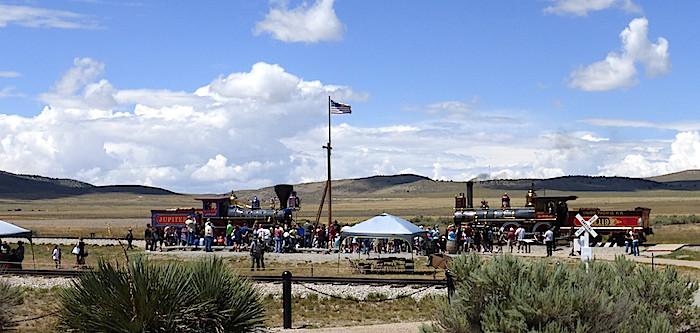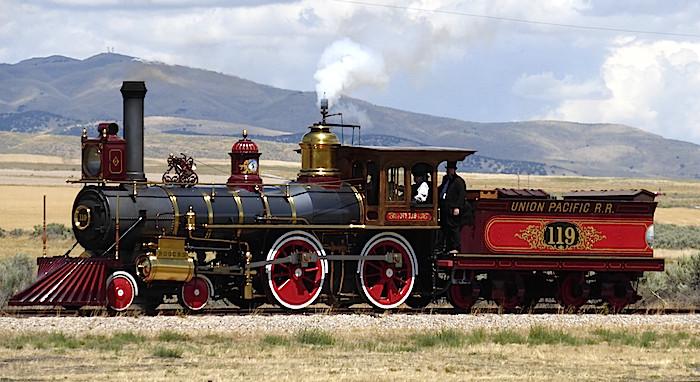
The Railroader's Festival came to Golden Spike National Historic Site in August/David and Kay Scott
In June we experienced a pleasant surprise during a visit to Scotts Bluff National Monument when the annual re-ride of the Pony Express made a short stop for a change of riders and horses during its 10-day St. Joseph to Sacramento ride. The bright sunny day in western Nebraska combined with the excitement of the Pony Express event made for a special experience at one of the major mileposts along the Oregon Trail.
In August we encountered another unexpected surprise at Utah’s Golden Spike National Historic Site when we happened to visit on the date of the site’s annual Railroader’s Festival. The visit to Golden Spike was near the end of a two-week trip tracing the Oregon Trail through Wyoming, Idaho, and Oregon, and we had no idea the festival was taking place until spotting a sign at the site’s entrance.
Although Golden Spike’s website states “the site’s location may result in visitors having to endure high winds, insects, heat, cold, and encounters with wildlife,” we encountered none of these and the day turned out to be a dream visit for individuals who are in love with the history of America’s railroads.
The Transcontinental Railroad
In 1862 Congress authorized the newly-formed Central Pacific and Union Pacific to begin construction of the country’s first transcontinental railroad. The Central Pacific would lay track eastward from Sacramento, while the Union Pacific was to build westward from the east, although the eastern terminus at the time was uncertain due to competing proposals for the route. Construction commenced in 1863, but progress was slow until the end of the Civil War when the South lost influence in determining the final route of the line. Omaha, Nebraska, was then chosen as the eastern terminus, and it was decided the route would follow the Mormon Trail along the north side of Nebraska’s Platte River. This route along the Platte remains a Union Pacific mainline that includes the world’s largest classification yard in the town of North Platte.
In return for undertaking the project, the two railroads were given loan subsidies, plus land sections for each mile of track completed. By 1864, the railroads had negotiated a better deal for themselves that included additional land subsidies that would pay big dividends in future years.
While the Union Pacific relied primarily on crews comprised of European immigrants, the lure of the California goldfields resulted in a shortage of labor on the West Coast. Thus, the Central Pacific employed many Chinese laborers to undertake the difficult work of laying track through the mountains.
Despite conflicts with the Cheyenne and Sioux, the flat landscape of the Platte River Valley allowed the Union Pacific to lay substantially more track than the Central Pacific, which was required to negotiate the difficult and hazardous Sierra Nevada range. By mid-1868, the Union Pacific had laid over three times as much track as the Central Pacific. When work was completed in mid-1869, the Union Pacific had laid 1,086 miles of track compared to 690 miles of track laid by the Central Pacific.
One interesting aspect of the mammoth rail venture resulted from the scheme used by the government to reward the two companies based on the amount of track each laid. When the Central Pacific and Union Pacific neared a meeting point in Utah, the two lines passed by one another and continued grading on a parallel course in order to generate additional subsidies. Congress eventually put an end of this waste by forcing the two railroads to connect their tracks at Promontory Summit.
The rail line that crossed the Promontory Summit was moved south to cross the northern arm of the Great Salt Lake on a 9-mile-long cutoff trestle in 1904 following the acquisition of the Central Pacific by the Southern Pacific. The move south eliminated nearly four dozen extreme grades and curves, plus saved 21 to 27 hours of travel time. (The Southern Pacific was acquired in 1995 by the Union Pacific).
Golden Spike National Historic Site
Golden Spike National Historic Site was designated a national historic site in 1957, although federal ownership did not occur until 1965. The 2,735-acre site preserves a 15-mile stretch of the transcontinental rail line that includes the location where the Central Pacific and Union Pacific met at Promontory Summit.
The visitor center, located near the site where the last spike was driven on May 10, 1869, contains exhibits, offers several video presentations, and stocks a wealth of adult and children’s railroad-themed books in the sales area. The historic site includes two unpaved one-way auto tour routes that follow the original grade of the rails. A self-guiding hiking trail east of the visitor center provides access to the "Big Fill," a large embankment across a deep ravine that was constructed by the Central Pacific. A large wood trestle constructed by the Union Pacific crossed the same ravine, but has since been removed.
While a visit to the site where the last rail spike was driven is well worth it because of its important place in American history, it is the replica locomotives, the Central Pacific’s Jupiter and the Union Pacific’s 119, that are the real treasures. The two locomotives are simply beautiful, and watching as they chug down the track toward one another is an inspiring sight. The locomotives operate each day from May 1 through Columbus Day. Reenactments of driving the last spike are offered Saturdays and holidays at 11 a.m. and 1:15 p.m. from the first of May through mid-September.
Special Activities at Golden Spike
The historic site offers three unique events in addition to celebrating National Parks Week and Public Lands Day. The annual celebration of the 1869 driving of the spike takes place each May 10 and a Winter Steam Festival is offered each year during the latter part of December. The Railroader’s Festival that we attended took place on the second Saturday of August. The event included handcar and motor car (speeder) rides, games for children, musical entertainment, and a food vendor in addition to two re-enactments and locomotive demonstrations. The festival took place under blue skies and calm winds. It was a wonderful day.

Visitors to Golden Spike National Historic Site in Utah can see Union Pacific Engine 119 chugging down the tracks/David and Kay Scott



Comments
This is one to put on your "bucket list.
The enactment jumps right out of most children's history texts. It is a true living history event. Share it with a child!
Thanks for the excellent background and vivid description.